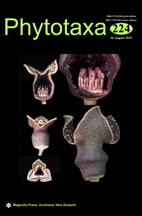Abstract
Persicaria (Linnaeus 1753: 360) Miller (1754) is a monophyletic genus including about 150 species mainly distributed in the northern temperate regions but also extends to tropical regions (Brandbyge 1993). The sect. Echinocaulon (Meisner 1832: 58) Gross (1913: 27), which is characterized in having recurved prickles on stems, petioles, and abaxial surfaces of major leaf veins, often scandent habit and hastate or sagittate leaf base (Galasso et al. 2009, Park 1988), was traditionally placed under Polygonum Linnaeus (1753: 360) (see e.g., Meisner 1856, Bentham & Hooker 1880, Dammer 1893, Steward 1930, Tutin et al. 1991, Li 1998, Li et al. 2003). On the basis of recent molecular studies (e.g., Kim & Donoghue 2008a, 2008b, Galasso et al. 2009, Sanchez et al. 2009, 2011), as well as morphological and anatomical investigations (Haraldson 1978, Ronse Decraene & Akeroyd 1988, Ronse Decraene et al. 2000), the taxon Echinocaulon has been confirmed to be placed in Persicaria.

